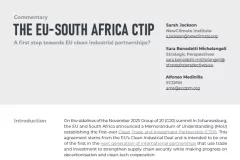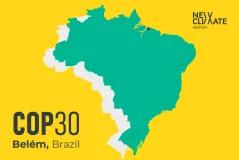Southeast Asia, the fastest-growing region in the developing world, is at a crossroads. On the one hand, it seeks to develop its economy and provide sufficient and affordable energy to power economic and social development, which has historically driven reliance on fossil fuels. On the other hand, the region is among the most vulnerable to the impacts of human-induced climate change – from deadly heatwaves to destructive floods – that are only intensifying with increased greenhouse gas emissions.
The key to balancing competing priorities in Southeast Asia -- energy security and economic development, and net-zero emissions -- lies in electrification, speedy renewables expansion and long-term energy system planning, experts from the region pointed out during a panel discussion hosted by NewClimate Institute and Agora Energiewende earlier this month. They particularly cautioned against the risks of relying on fossil fuels, especially fossil gas, which is considered a “transition fuel” in the region.
The event brought together regional experts to discuss findings from the research brief “Navigating the transition to net-zero emissions in Southeast Asia,” which compared net-zero pathways focused on reducing fossil fuel use through electrification versus using renewable gases like hydrogen. The brief examined Indonesia, Thailand, Viet Nam, and the Philippines as part of “Clean, Affordable and Secure Energy for Southeast Asia (CASE)” project.
The main challenge for Southeast Asia is to secure affordable and reliable energy supply to meet rising energy demand while decarbonising its energy sectors. Many of ASEAN’s 10 member states set their own climate targets and energy transition plans, with eight committed to net zero by 2050. The ASEAN region is on track to meet its collective target of expanding renewable generation capacity to 35% by 2025. However, governments also plan to increase the use of fossil gas, especially liquefied natural gas, viewing it as a less polluting alternative to coal during the transition to renewables.
Hidden costs of fossil fuel reliance
Angelika David, manager for energy policy at the Institute for Climate and Sustainable Cities in the Philippines, emphasised the “hidden costs” of relying on fossil fuels. Electricity prices in the Philippines are among the highest in Southeast Asia, largely due to its heavy reliance on imported coal for electricity generation. In 2021, about 59 percent of electricity was generated from coal, with nearly 65 percent of its coal supply imported, primarily from Indonesia, making it vulnerable to fluctuations in global fuel prices.
“Recent power outages underscore the vulnerability of our dependence on fossil fuels in a centralized, baseload-heavy power grid,” David said during the panel discussion, referring to several power outages this year in the Philippines’ Luzon and the Visayas regions – the country’s two of three main island groups. These disruptions are attributed to issues linked to fossil fuel power plants, such as unplanned shutdowns due to technical failures, aging infrastructure, or soaring peak-time demands.
“To reach the climate targets in the Philippines, it's important to focus on necessary changes in power systems planning and policy making,” she said. “Transitioning to a more flexible and distributed power generation through renewable energy sources would be the solution.”
Expanding fossil gas infrastructure risks worsening the region’s import dependence, another expert pointed out, given rapidly declining gas reserves.
“Southeast Asia is highly cost-sensitive and will become a net gas importer in the next few years. Within the next decade, even some of the largest gas-producing countries in the region will start importing gas as their own resources deplete,” said Putra Adhiguna, managing director at the Energy Shift Institute. ASEAN countries are likely to be net importers of gas by 2025, according to the ASEAN Centre for Energy and International Energy Agency.
Adhiguna also noted that new gas infrastructure could become a costly stranded asset, as gas plants would need to retire before their economic lifespan to meet global and national climate targets. Furthermore, continued gas use could divert limited resources from investing in renewable infrastructure. “The lock-in risk is quite real. We need to look at it from a whole system perspective,” Adhiguna said.
To avoid these risks, it is crucial that renewables capacity and grid infrastructure are rolled out rapidly enough to prevent the influx of the gas sector and backtracking of the governments on their climate commitments, he added.
The way forward: electrification, renewables scale-up, and flexibility
In Vietnam, major challenges in achieving net zero arise from energy security and affordability, according to Dr. Pham Hoang Luong, director of the Vietnam-Japan International Institute for Science and Technology and a senior lecturer at Hanoi University of Science and Technology.
“As the country’s power supply has relied mainly on fossil fuels, it is not easy to shift directly from fossil fuels to cleaner energy sources. It needs a roadmap and action plan to be implemented gradually to guarantee energy security, which is crucial to the nation’s development,” he said.
The new research brief offers key action points for the CASE countries to improve energy efficiency and affordability while reducing overall energy needs: electrifying energy end-use, such as switching to electric vehicles or heat pumps in industrial processes and using electricity sourced from renewables directly to replace fossil fuels.
“So we will need much more electricity. And for this to be carbon neutral, we need renewable electricity. And to align with net-zero targets, the speed of renewable electricity deployment must increase significantly beyond current government plans,” said Hanna Fekete from NewClimate Institute.
Rapid expansion of renewable infrastructure would require substantial investments, policy support and long-term energy system planning. And energy systems must become more flexible to accommodate shifts in energy carriers and changing patterns in electricity demand. “The system flexibility becomes a cornerstone of energy security. Such a system requires much more electricity storage. It also requires much more demand-side responses,” Fekete added.
Fundamentally, to underpin such shifts, “energy security” should be redefined, according to Mathis Rogner, project leader at Agora Energiewende.
“How we view ‘energy security’ must shift from ‘securing fossil fuels through import contracts or domestic resources’ to one that emphasizes renewable energy, system flexibility and resilience,” he said – a system that minimises energy demand and supplies sufficient electricity efficiently without exacerbating the climate crisis.
“What we should focus efforts on now is really to build renewables and working to build systems that allow for those renewables to contribute most effectively. For example, by investing in improving system operations and in power grids not only in infrastructure, but also in processes and institutions that serve them,” Rogner said.
Written by Hyunju (Laeticia) Ock, Writer and Editor at NewClimate Institute
This article was first published on SIPET website.







